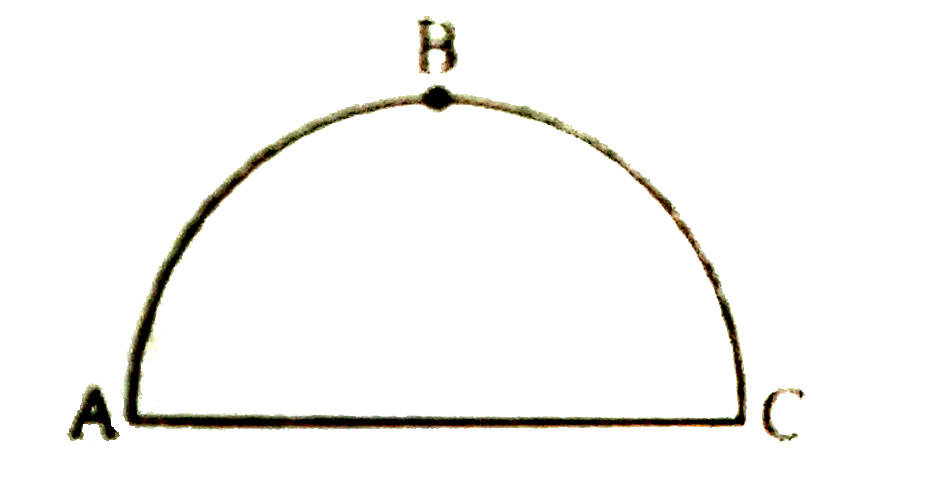A particle of mass 10 g moves along a circle of radius 6.4 cm with a constant tangential acceleration. What is the magnitude of this acceleration. What is the magnitude of this acceleration, if the kinetic energy of the particle becomes equal to 8×10−4J by the end of the second revolution after the beginning of the motion?
0.1 m/s2
0.15m/s2
0.18m/s2
0.2m/s2
The correct Answer is:A
Step by step video, text & image solution for A particle of mass 10 g moves along a circle of radius 6.4 cm with a constant tangential acceleration. What is the magnitude of this acceleration. What is the magnitude of this acceleration, if the kinetic energy of the particle becomes equal to 8xx10^(-4)J by the end of the second revolution after the beginning of the motion? by Physics experts to help you in doubts & scoring excellent marks in Class 12 exams.
Topper's Solved these Questions
- BOOK - MOTIONCHAPTER - CIRCULAR MOTIONEXERCISE - EXERCISE - 3 SECTION - B8videos
CIRCULAR MOTION
- BOOK - MOTIONCHAPTER - CIRCULAR MOTIONEXERCISE - EXERCISE - 416videos
CIRCULAR MOTION
- BOOK - MOTIONCHAPTER - CIRCULAR MOTIONEXERCISE - EXERCISE - 216videos
CIRCULAR MOTION
- BOOK - MOTIONCHAPTER - CENTRE OF MASSEXERCISE - Exercise - 4 Level-II20videos
CENTRE OF MASS
- BOOK - MOTIONCHAPTER - COMMUNICATION SYSTEMEXERCISE - EXERCISE - 36videos
COMMUNICATION SYSTEM
Similar Questions
A particle of mass 10 g moves along a circle of the radius 1π cm with a constant tangential acceleration. What is the magnitude of this acceleration (in ms−1) if the kinetic nergy of the particle becomes equal to 8×10−4J by the end of the second revolution after the beginning of the motion? (Particle starts from rest)
View SolutionA particle of mass 10 g moves along a circle of radius 64 cm with a constant tangential acceleration. What is the magnitude of this acceleration if the kinetic energy of the particle becomes equal to 8×10−4J by the end of the second revolution after the beginning of the motion ?
View Solution
Knowledge Check
- Question 1 - Select One
A paritcal of mass 10g moves along a circle of radius 6.4cm with a constant tangennitial acceleration. What is the magnitude of this acceleration . What is the magnitude of this acceleration if the kinetic energy of the partical becomes equal to 8×10−4J by the end of the second revolution after the beginning of the motion?
A0.2m/s2B0.1m/s2C0.15m/s2D0.18m/s2 - Question 2 - Select One
A particle of mass 10 g moves along a circle of radius 6.4 cm with a constant tangential acceleration. What is the magnitude of this acceleration if the kinetic energy of the particle becomes equal to 8×10−4J by the end of the second revolution after the beginning of the motion?
A0.18m/s2B0.2m/s2C0.1m/s2D0.15m/s2 - Question 3 - Select One
A particle of mass 10 g moves along a circle of radius 64 cm with a constant tangential acceleration. What is the magnitude of this acceleration if the kinetic energy of the particle becomes equal to 8×10−4J by the end of the second revolution after the beginning of the motion ?
A0.02m/s2B0.01m/s2C0.015m/s2D0.018m/s2
A particle moves in a circle of radius 2 m at a second
what is its resultant (total ) acceleration at time t=1 s ?View SolutionIf a particle of mass m start from along curved circular path shown in figure with constant tangential acceleration a, then net force at B on the particle has the magnitude :
 View Solution
View SolutionA particle moves along a circle of radius 40π m with constant tangental acceleration. If the velocity of the particle is 100 m/s at the end of the 4th revolution after motion has begin, the tangential acceleration is
View SolutionA particle moves along a circle of radius r with constant tangential acceleration. If the velocity of the particle is v at the end of second revolution, after the revolution has started, then the tangential acceleration is
View SolutionA particle moves in a circle of radius 5 cm with constant speed and time period 0.2πs. The acceleration of the particle is
View Solution

